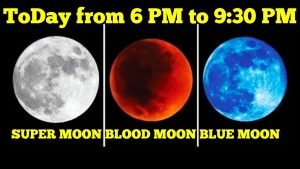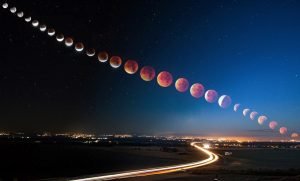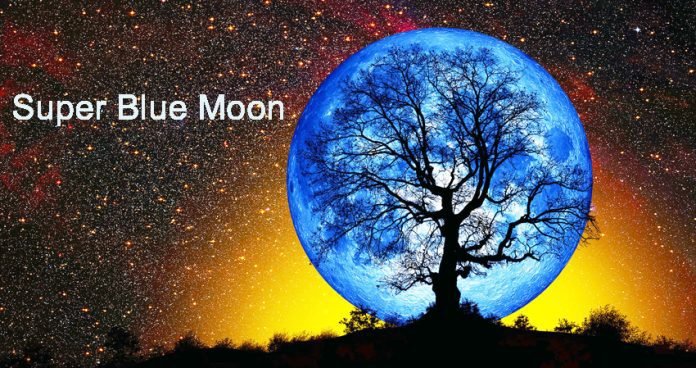Get ready to witness a rare celestial event ” super blue moon ” will grace sky at night on August 30.
A “super blue moon” is a rare celestial event that combines three lunar phenomena: a supermoon, a blue moon, and a total lunar eclipse. Let’s break down each of these terms:


- Supermoon: A supermoon occurs when the moon is at its closest point to Earth in its elliptical orbit, known as the perigee. This makes the moon appear slightly larger and brighter in the sky than during a typical full moon. Supermoons can appear up to 14% larger and 30% brighter than when the moon is at its farthest point from Earth (apogee).
- Blue Moon: How often is a blue moon ?As previously mentioned, a blue moon refers to the second full moon within a calendar month. This phenomenon is relatively rare and occurs approximately once every 2.7 years.
- Total Lunar Eclipse: A total lunar eclipse occurs when the Earth passes directly between the sun and the moon, casting a shadow on the moon. During a total lunar eclipse, the moon can take on a reddish hue due to the scattering of sunlight through Earth’s atmosphere. This phenomenon is often referred to as a “blood moon.”


When these three events coincide—supermoon, blue moon, and total lunar eclipse—it creates what is known as a “super blue blood moon.” This convergence of events is quite rare and can make for a stunning celestial spectacle. However, because these individual events are already relatively infrequent, the occurrence of a super blue blood moon is even rarer.
It’s important to note that the specific timing and visibility of such events can vary based on your location and time zone. If you’re interested in witnessing a super blue blood moon, it’s a good idea to keep an eye on astronomical event calendars and announcements to know when and where to observe this extraordinary occurrence.
A blue moon is a term used to describe the second full moon that occurs within a single calendar month. It’s important to note that the term “blue moon” has nothing to do with the actual color of the moon. The moon can sometimes appear bluish in the sky due to certain atmospheric conditions, but that’s a separate phenomenon.


The term “blue moon” gained popularity and attention due to its rarity and the way it’s used to describe an infrequent occurrence in the lunar cycle. Typically, there is one full moon in each calendar month, which is a natural consequence of the moon’s roughly 29.5-day lunar cycle. However, because most calendar months are longer than the lunar cycle, there are occasions when two full moons occur within a single month.
The phrase “blue moon” has been used historically to refer to something rare or unlikely, and it was eventually applied to the occurrence of a second full moon in a calendar month, further emphasizing its rarity. This phenomenon happens approximately once every 2.7 years on average, making it a relatively infrequent event.
A blue moon occurs when there are two full moons within a single calendar month. This phenomenon happens due to the difference between the lunar month (approximately 29.5 days) and the calendar month (usually 30 or 31 days). The second full moon in a calendar month is referred to as the “blue moon.”
To give you an example, if a full moon occurs on the first or second day of a calendar month, there’s a chance that a second full moon could occur on the last day of that same month, creating a blue moon. Similarly, if a month begins with a full moon at the very end of the previous month, there’s an opportunity for a second full moon to happen in the new month.
It’s important to note that the exact dates of blue moons can vary depending on your time zone and location. Blue moons are relatively rare, happening approximately once every 2.7 years on average.
some interesting facts about a blue moon:
- Rare Occurrence: A blue moon is often referred to as the second full moon within a calendar month. This phenomenon is relatively rare, occurring approximately once every 2.7 years, due to the discrepancy between the lunar month (about 29.5 days) and the calendar month (about 30 or 31 days).
- The Term “Blue” Moon: The term “blue moon” has nothing to do with the moon’s actual color. The moon can appear blue in rare circumstances, such as when there are certain atmospheric conditions like the presence of smoke or dust particles. However, the term “blue moon” specifically refers to the occurrence of a second full moon within a single calendar month.
- Origin of the Phrase: The phrase “blue moon” has been in use for centuries to refer to something rare or unlikely. The exact origin of the term’s application to the moon is a bit unclear, but it gained widespread attention in the 20th century after being featured in an article in Sky & Telescope magazine in 1946.
- Different Definitions: Prior to the modern usage of the term, a “blue moon” was sometimes defined as the third full moon in a season that has four full moons, instead of the usual three. This definition is less commonly used today.
- Full Moon Schedule: Normally, there is a full moon approximately every 29.5 days, which means there are about 12.37 full moons in a year. Since most calendar months have only 30 or 31 days, it’s relatively common for two full moons to occur within one month at some point.
- Variation in Dates: The dates of blue moons can vary across time zones and locations. The second full moon of a calendar month could fall on different dates depending on where you are on Earth.
- Cultural and Folklore Significance: In various cultures and traditions, the full moon has been associated with different beliefs and rituals. While the concept of a blue moon has gained modern attention, it doesn’t carry significant cultural or traditional meanings as some other lunar phenomena do.
- Calendar Adjustments: The concept of a blue moon can also affect the scheduling of certain events or holidays that are tied to lunar cycles. For example, Easter is determined based on the moon’s cycles, and the occurrence of a blue moon can influence its date.
Remember, the blue moon’s significance lies more in its occasional rarity and how the phrase has captured the imagination, rather than any inherent scientific or cultural significance tied directly to the moon’s appearance.

